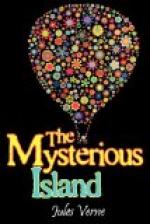On the first cone rested a second, slightly rounded, and placed a little on one side, like a great round hat cocked over the ear. A Scotchman would have said, “His bonnet was a thocht ajee.” It appeared formed of bare earth, here and there pierced by reddish rocks.
They wished to reach the second cone, and proceeding along the ridge of the spurs seemed to be the best way by which to gain it.
“We are on volcanic ground,” Cyrus Harding had said, and his companions following him began to ascend by degrees on the back of a spur, which, by a winding and consequently more accessible path, joined the first plateau.
The ground had evidently been convulsed by subterranean force. Here and there stray blocks, numerous debris of basalt and pumice-stone, were met with. In isolated groups rose fir-trees, which, some hundred feet lower, at the bottom of the narrow gorges, formed massive shades almost impenetrable to the sun’s rays.
During the first part of the ascent, Herbert remarked on the footprints which indicated the recent passage of large animals.
“Perhaps these beasts will not let us pass by willingly,” said Pencroft.
“Well,” replied the reporter, who had already hunted the tiger in India, and the lion in Africa, “we shall soon learn how successfully to encounter them. But in the meantime we must be upon our guard!”
They ascended but slowly.
The distance, increased by detours and obstacles which could not be surmounted directly, was long. Sometimes, too, the ground suddenly fell, and they found themselves on the edge of a deep chasm which they had to go round. Thus, in retracing their steps so as to find some practicable path, much time was employed and fatigue undergone for nothing. At twelve o’clock, when the small band of adventurers halted for breakfast at the foot of a large group of firs, near a little stream which fell in cascades, they found themselves still half way from the first plateau, which most probably they would not reach till nightfall. From this point the view of the sea was much extended, but on the right the high promontory prevented their seeing whether there was land beyond it. On the left, the sight extended several miles to the north; but, on the northwest, at the point occupied by the explorers, it was cut short by the ridge of a fantastically-shaped spur, which formed a powerful support of the central cone.
At one o’clock the ascent was continued. They slanted more towards the southwest and again entered among thick bushes. There under the shade of the trees fluttered several couples of gallinaceae belonging to the pheasant species. They were tragopans, ornamented by a pendant skin which hangs over their throats, and by two small, round horns, planted behind the eyes. Among these birds, which were about the size of a fowl, the female was uniformly brown, while the male was gorgeous in his red plumage, decorated with white spots. Gideon Spilett, with a stone cleverly and vigorously thrown, killed one of these tragopans, on which Pencroft, made hungry by the fresh air, had cast greedy eyes.




